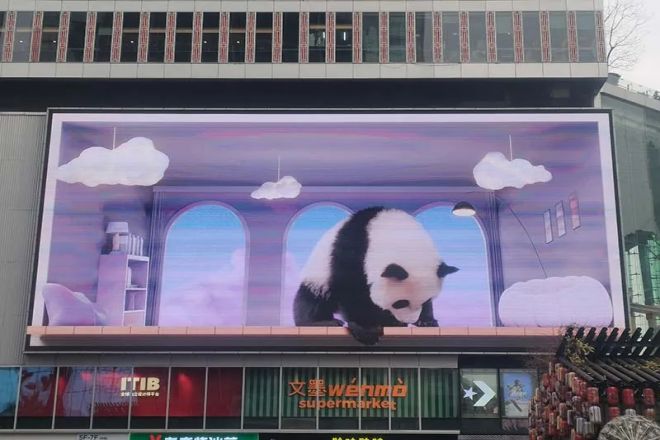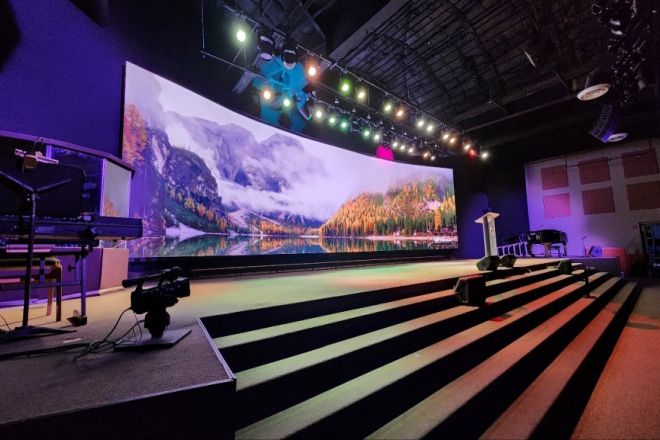Introduction

In the wave of the digital age, giant screen LED displays, as an important carrier of modern media, have been widely used in various occasions, such as large-scale sports events, outdoor advertising, commercial exhibitions, etc.
Its excellent display effect and strong visual impact make the giant screen LED display a weapon to attract the audience’s attention. However, for many companies or individuals who want to buy giant screen LED displays, the cost issue is often a consideration that cannot be ignored.
1. Factors affecting the cost of giant screen LED display
- Dot pitch:
Dot pitch is an important parameter of LED display, usually expressed by P value, such as P1.8, P2.0, P2.5, P3, etc. The smaller the dot pitch, the higher the pixel density of the display and the more delicate the display effect, but the cost also increases accordingly.
For conference rooms or places that require a high-definition display, the dot pitch between P0.9 and P3 is generally selected, and the price range is roughly between 3,000 yuan and 18,000 yuan/square meter.
- Screen size:
The screen size directly determines the amount of materials and manufacturing cost required for the display. Generally speaking, the larger the screen size, the more LED lamp beads, driver chips, etc. are required, so the cost is also higher. Large-scale procurement may sometimes get a more favorable unit price, but the overall cost is still relatively high.
- Raw materials and processes:
The raw materials of LED display screens include core components such as LED lamp beads, driver ICs, and control systems. The quality of raw materials and manufacturing processes directly affect the performance and life of the display screen.
For example, using imported LED chips (such as American and Japanese brands) may cost more, but the performance is more stable, while domestic chips may be more cost-effective.
In addition, different manufacturing technologies and processes (such as OLED technology) will also affect the cost.
- Customization requirements:
LED display screens with special shapes (such as curved screens and special-shaped screens) need to be customized according to customer needs, which increases the complexity of design, manufacturing and installation. Customization requirements such as installation structure, the waterproof and dustproof level will also increase additional costs. These customized requirements may lead to a significant increase in overall costs.
- After-sales service:
A complete after-sales guarantee system, including installation, commissioning, maintenance, and other services, is the key to ensuring the long-term and stable operation of LED display screens. The quality and coverage of after-sales service will also affect the cost.
Some well-known brands may provide more comprehensive after-sales service guarantees, but the price is correspondingly higher. However, in the long run, good after-sales service can reduce maintenance costs and extend the service life of the display.
2. Cost composition of giant screen LED display

- Screen price:
Screen price is the main component of the cost of a giant screen LED display, usually calculated by box, module, or square area.
The price is closely related to the screen size and dot pitch. Generally speaking, the larger the screen size and the smaller the dot pitch, the higher the price. For example, a P2.5 dot pitch LED display may cost between 5,000 yuan and 10,000 yuan per square meter, while a P1.8 dot pitch display may cost more than 15,000 yuan per square meter.
In addition, the prices of LED displays for different brands and models will vary. Some high-end brands or special models of display screens may be more expensive due to the use of more advanced technology and materials.
- Control system:
The control system is an integral part of the giant screen LED display and is usually sold together with the screen.
The price of the control system depends on the size and resolution of the display. Generally speaking, the larger the display and the higher the resolution, the more complex the control system required and the higher the price.
The function of the control system will also affect the price. Some high-end control systems have more powerful image processing capabilities and playback functions, and the price will naturally be higher.
- Computer audio:
When playing full-color LED display screens, computers are key equipment for synchronous playback of content and music effects.
The cost of a computer depends on its configuration and brand. Generally speaking, playing high-definition video and audio requires a computer with a higher configuration, and the cost will increase accordingly.
However, in some simple application scenarios, it may only be necessary to use a computer with a lower configuration or even no computer, thereby reducing costs.
- Engineering construction:
Engineering construction is an important part of the giant screen LED display project, including civil engineering, steel structure frame, exterior decoration engineering, and strong and weak power wiring engineering.
Civil engineering mainly involves excavation, backfilling, and pouring concrete for the foundation, and its cost is usually related to the size of the display screen and the installation environment.
The steel structure frame is used to support the weight of the display screen and maintain stability, and its cost depends on the amount of steel used and the complexity of processing.
The exterior decoration project mainly includes appearance decoration and waterproof and dustproof treatment of the display screen, and its cost depends on the type and quantity of decorative materials used.
The strong and weak power wiring project involves the installation and wiring of cables, cable ducts, switches, and other equipment. Its cost depends on the power consumption and wiring complexity of the display screen.
In general, the construction cost accounts for a certain proportion of the entire giant screen LED display project, and it is necessary to consider various factors for budgeting.
3. Market reference price range
1). Reference price range based on dot pitch:
- P4 and above dot pitch (lower resolution):
This type of display is usually used in scenes such as outdoor advertising or large-scale sports events. Due to the large dot pitch and relatively low resolution, the price is relatively affordable. The market reference price range is roughly between 1,500 yuan and 5,000 yuan per square meter.
- P2.5 to P3 dot pitch (medium resolution):
Suitable for commercial displays, conference rooms, and other occasions that require a certain degree of clarity. The price is relatively high, and the market reference price range is between 5,000 yuan and 10,000 yuan per square meter.
- P1.8 to P2 dot pitch (high resolution):
This type of display has extremely high clarity and is suitable for high-end commercial displays, stage backgrounds, and other scenes. The price is expensive, and the market reference price range is between 10,000 yuan and 20,000 yuan per square meter or higher.
2). Reference price range based on screen size:
- Small giant screen (such as 5m × 3m):
Even with a high-resolution dot pitch, the price is relatively controllable due to the small overall area. The market reference price may be between tens of thousands and hundreds of thousands of yuan.
- Medium giant screen (such as 10m × 5m):
This size of the display screen is widely used, and the price varies depending on factors such as dot pitch and brand. The market reference price may be between hundreds of thousands and millions of yuan.
- Large giant screen (such as 20m × 10m and above):
Large giant screen displays are usually used in large outdoor advertising, sports events, and other occasions, and the price is high. The market reference price may be as high as millions or even tens of millions of yuan.
3). Other factors:
It should be emphasized that the above prices are only market reference ranges, and actual purchases need to be made based on specific needs, brands, after-sales service, and other factors.
Market fluctuations, supplier strategies, customized needs, and other factors may affect the final price. Therefore, be sure to conduct sufficient market research and comparison before purchasing.
By comprehensively considering dot pitch, screen size, and other factors, readers can have a general understanding of the price of giant screen LED display screens and make more informed decisions when purchasing.
4. Purchase suggestions and precautions

- Choose the appropriate dot pitch and screen size according to actual needs:
When purchasing a giant screen LED display, you must first clarify your actual needs, including usage scenarios, viewing distance, budget, and other factors. Choose the appropriate dot pitch and screen size based on these factors to avoid unnecessary waste caused by purchasing too large or too small display screens.
- Focus on product quality and after-sales service:
LED display screens are long-term equipment, so product quality and after-sales service are crucial. When purchasing, you should choose reputable suppliers and brands to ensure reliable product quality and perfect after-sales service. You can evaluate by checking the supplier’s qualifications, customer reviews, etc.
- Consider transportation and installation costs:
The transportation and installation costs of giant screen LED displays may account for a considerable part of the total cost. Before purchasing, you should fully understand the transportation and installation services provided by the supplier and calculate the relevant costs. If the supplier does not provide transportation and installation services, you need to find a reliable partner for negotiation.
- Clearly define the rights and obligations of both parties when signing a contract:
When purchasing a giant screen LED display, a detailed contract should be signed to clarify the rights and obligations of both parties. The contract should include but is not limited to the following: product specifications, prices, payment methods, delivery time, transportation and installation responsibilities, after-sales service, etc. Ensure that the contract content is complete and clear to avoid disputes in the subsequent process.
- Understand the warranty policy and technical support:
Warranty policy and technical support are important factors to consider when purchasing LED display screens. Understand the supplier’s warranty policy and technical support scope to ensure that the equipment can be promptly and effectively resolved when it fails.
- Field investigation and testing:
Before purchasing, if conditions permit, it is recommended to conduct field investigation and testing. Through field investigation, you can understand the supplier’s production environment, technical strength, etc.; through testing, you can evaluate the actual effect and performance of the display. This helps to make a more informed purchase decision.
- Compare different suppliers and products:
Before purchasing, it is recommended to compare the price, performance, quality, etc., of different suppliers and products. By comparison, you can choose a more cost-effective product and reduce the purchase cost. At the same time, you can also understand the service level and market reputation of different suppliers.
Conclusion
Through the discussion in this article, it is not difficult to find that the cost of purchasing a giant screen LED display involves many aspects, including screen size, dot pitch, raw materials and processes, customization requirements, and after-sales service. In the actual purchase process, we need to consider these factors comprehensively according to our own needs and budget and choose the product that best suits us.
Finally, if you want to know more about LED display screens, please get in touch with us.
